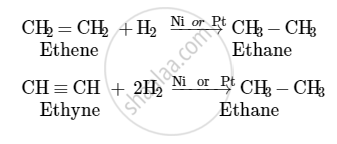Advertisements
Advertisements
Questions
Write the name and general formula of a chain of hydrocarbons in which an addition reaction with hydrogen is possible. State the essential condition for an addition reaction. Stating this condition, write a chemical equation giving the name of the reactant and the product of the reaction.
Write the name and general formula of a chain of hydrocarbons in which an addition reaction with hydrogen can take place. Stating the essential conditions required for an addition reaction to occur, write the chemical equation giving the name of the reactant and the product of such a reaction.
Solution 1
Name and general formula of hydrocarbons undergoing addition reaction with hydrogen:
| Name | General Formula |
| Alkene | CnH2n |
| Alkyne | CnH2n-2 |
Essential conditions required for the addition reaction to occur:-
- Multiple bonds (double and triple bonds) must be present between carbon atoms in the chain of hydrocarbon.
- Addition of hydrogen should be carried out in the presence of catalyst such as nickel or platinum.
Chemical Equation:-

Solution 2
The addition of hydrogen is possible in alkenes and alkynes. This is because of the presence of double and triple bonds, respectively. The general formula of alkenes is CnH2n and that of alkynes is CnH2n−2.
Conditions for addition reactions are
- Presence of an unsaturated compound, i.e. an unsaturated hydrocarbon.
- Presence of a species to be added to an unsaturated compound.
- Presence of a catalyst such as finely divided palladium or nickel.

APPEARS IN
RELATED QUESTIONS
Draw the structures for Ethanoic acid.
Draw the structures for Hexanal.
Give the name and structural formula of one member each of the following:
alkyne
Write the molecular formula and structure of benzene.
Write the molecular formula and structure of cyclohexane. How many covalent bonds are there in a molecule of cyclohexane?
What are hydrocarbons? Explain with examples.
A diamond-toothed saw is usually used for cutting:
(a) steel girders
(b) logs of wood
(c) marble slabs
(d) asbestos sheets
Two organic compounds A and B have the same molecular formula C6H12. Write the names and structural formulae:
Which compound contains only single bonds?
Recognise the carbon chain type of the following:
\[\begin{array}{cc}
\ce{H}\phantom{...}\ce{H}\phantom{...}\ce{H}\phantom{...}\ce{H}\\
|\phantom{....}|\phantom{....}|\phantom{....}|\\\ce{H - C - C - C - C - H}\\|\phantom{....}|\phantom{....}|\phantom{....}|\\
\ce{H}\phantom{...}\ce{H}\phantom{...}\ce{H}\phantom{...}\ce{H}
\end{array}\]
Draw the structure of propanol.
